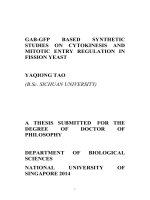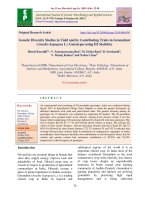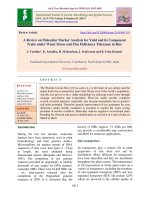Genetic variability studies on yield and yield component traits of soybean
Bạn đang xem bản rút gọn của tài liệu. Xem và tải ngay bản đầy đủ của tài liệu tại đây (122.5 KB, 6 trang )
Int.J.Curr.Microbiol.App.Sci (2019) 8(2): 1269-1274
International Journal of Current Microbiology and Applied Sciences
ISSN: 2319-7706 Volume 8 Number 02 (2019)
Journal homepage:
Original Research Article
/>
Genetic Variability Studies on Yield and Yield Component
Traits of Soybean
Shruti Koraddi* and G.T. Basavaraja
Department of Genetics and Plant Breeding, ANGRAU, Agricultural College, Bapatla, India
*Corresponding author
ABSTRACT
Keywords
Genetic variability,
heritability, soybean
and Genetic
advance
Article Info
Accepted:
10 January 2019
Available Online:
10 February 2019
A study on variability, heritability and genetic advance in 13 genotypes of soybean were
carried out for yield and yield component traits. Observations on 11 characters were
recorded. Analysis of variance revealed highly significant differences among the
genotypes for the all the characters. The range was maximum for plant height (39.2777.73) followed by number of pods per plant (35.87-61.40). The genotypic coefficient of
variation and phenotypic coefficient of variation were high for pod weight per plant (g)
followed by seed yield per plant (g) indicate the presence of wider adaptability for these
traits in the genotypes studied, suggested the less influence of environment in the
expression of characters. High heritability coupled with high genetic advance as percent of
mean was observed for days to 50% flowering, plant height (cm), number of pods per
plant, number of seeds per pod, pod weight per plant,100 seed weight, biomass and seed
yield per plant indicating additive gene action and the ample scope for improvement in
these traits through simple selection.
Introduction
Soybean (Glycine max (L.) Merrill) being a
potentially high yielding crop can play an
important role in boosting oil seed production
in the country. It is referred as miracle crop of
20th century, as it contains 40% high quality
protein and 20 % oil. It is also rich in lycine
(6.4%) and Vitamin A, B and D. Quality of
soy protein is next to animal protein and
better than cereals and pulses. The edible oil
in soybean is approximately 85 % unsaturated
and contains essential fatty acids. Its oil is
also used as a raw material in manufacturing
antibiotics, paints, adhesives and lubricants
etc. At present, soybean occupies an area of
113.10 m ha producing 283.79 mt with the
productivity of 2509 kg ha-1 in the world
(Anon., 2013). In India, it occupies an area of
12.03 m ha with the production of 12.45 mt
and productivity of 1035 kg ha-1 (Anon.,
2013). In Karnataka, soybean is grown over
an area of 0.25 m ha with a production of 0.30
mt and productivity of about 1215 kg ha-1
(Anon., 2013).
In the absence of ample genetic variability,
the existing genetic material, creation and
assessment of genetic variability is a basic
step in crop improvement programme. Yield
being a complex character influenced by a
number of yield contributing characters
1269
Int.J.Curr.Microbiol.App.Sci (2019) 8(2): 1269-1274
controlled by polygenes and also influenced
by environment. Hence, it becomes necessary
to partition the observed variability into
heritable and non heritable components
measured as genotypic and phenotypic
coefficients of variations (PCV and GCV),
heritability and genetic advance to account for
created variability to be used in breeding
programmes.
Materials and Methods
The experimental material for the present
study comprised of eight advanced breeding
lines which are cross derivatives of JS 335 x
EC 241778, JS 335 x EC 241780, JS 93-05 x
EC 241780, DSb12 x EC 241780 developed
at AICRP on soybean, University of
Agricultural Sciences, Dharwad, along with
five parents.
The field experiment was conducted during
kharif 2013. The experiment consisting of 13
genotypes was laid out in a Randomized
Complete Block Design with three
replications. The genotypes studied are given
in (Table.1). The genotypes were sown in
three rows each of four meter length with
spacing of 30 cm between rows and 10 cm
between the plants. The recommended
package of practices was followed for raising
a good crop.
Five plants were selected at random in each
plot to record the observations on days to
50% flowering, plant height (cm), number of
branches per plant, number of pods per plant,
pod length (cm), pod weight per plant (g),
number of seeds per pod, 100 seed weight (g),
seed yield per plant (g), biomass per plant (g)
and harvest index (%). The mean data were
analysed to work out the variance components
and coefficient of variance following Burton
(1952). The heritability in broad sense and
expected genetic advance were computed as
per Johnson et al., (1955).
Results and Discussion
The analysis of variance revealed the
presence of significant differences for all the
traits studied indicating the existence of
genetic differences among the genotypes
(Table 2). Days to 50 per cent flowering
ranged from 33 days to 50.66 days with a
mean value of 42.67 days (Table 3). The plant
height ranging from 39.27 cm to 77.73 cm
with a mean value of 56.84 cm. The mean
value for the number of branches per plant
ranged from 3.27 to 4.47 with a mean value of
3.94. A wide range of variation for number of
pods per plant ranged from 35.87 (JS 93-05)
to 61.40 (DSb 23-2) with a mean value of
49.18, 100 seed weight from 9.50g to 13.43 g,
Biomass per plant (g) ranged from 23.95g to
44.10g, Harvest index ranged from 38.98 per
cent to 54.31 per cent. Seed yield per plant
mean was 16.34 g with a range of 9.27 g (JS
93-05) to 23.95 g (DSb 23-2). A similar
finding was reported for plant height and
number of pods per plant by Parameshwar
(2006). The presence of wide variability for
different traits indicated the presence of
variability for the traits and scope for
improvement.
The phenotypic coefficient of variability was
higher than genotypic coefficient of
variability for all the characters studied (Table
3). Plant height, pod weight per plant, seed
yield per plant exhibited high genotypic and
phenotypic coefficient of variation. The
results indicated existence of substantial
variability for these characters. It also
indicated greater scope for selection to
improve these characters. Similar findings
were reported Ramana et al., (2000),
Shivakumar et al., (2011) and Radhika
(2012). Moderate values of PCV and GCV
were noticed for characters viz., days to 50%
flowering, number of branches per plant,
number of pods per plant, 100 seed weight,
number of seeds per pod and biomass per
1270
Int.J.Curr.Microbiol.App.Sci (2019) 8(2): 1269-1274
plant. Pod length and harvest index exhibited
low PCV and GCV. A lower value of PCV
and GCV for these traits suggests that there is
ample scope to enrich the variation for these
characters.
The coefficient of variation indicates only the
extent of variability existing for various
characters, but does not give any information
regarding heritable proportion of it. Hence,
amount of heritability permits greater
effectiveness of selection by separating out
the environmental influence from the total
variability and to indicate accuracy with
which a genotype can be identified
phenotypically. In the present study, broad
sense heritability, which includes both
additive and non-additive gene effects
(Hanson et al., 1956), was estimated. The
results indicated that estimates of heritability
were high for the characters under study viz.,
days to 50 % flowering, plant height, number
of branches per plant, pod length, pods per
plant, number of seeds per pod, pod weight,
100 seed weight, biomass and seed yield. It
thus indicated that better expression of these
traits is primarily due to genetic factors and
hence fixable. Similar results were reported
by Shivakumar et al., (2011) for days to 50%
flowering, Mukesh Kumar and Singh (2009).
Moderate heritability values were observed
for harvest index indicating moderate
influence of the environment on its
expression. Hence selection for such trait
should be based on the performance across
locations over years.
Heritability estimates of the 13 genotypes
revealed that high heritability coupled with
high genetic advance as per cent mean was
observed for days to 50 % flowering, plant
height, number of pods per plant, pod weight,
number of seeds per pod, 100 seed weight,
biomass and seed yield per plant.
Table.1 Pedigree of the genotypes used in the study
Sl.No.
1
2
3
4
5
6
7
8
9
10
11
12
13
Genotypes
Pedigree
JS 335 x EC 241778
JS 335 x EC 241780
JS 93-05 x EC 241780
DSb 12 x EC241780
DSb 12 x EC241780
JS 335 x EC241780
JS 335 x EC241780
JS 335 x EC241780
An exotic germplasm line
An exotic germplasm line
JS 335 x PS 73-7
Selection from PS 73-22
JS78-77 x JS71-05
DSb 21
DSb 23-2
DSb 28-3
Line No.9-1
Line No.9-2
Line No.9-3
Line No.30-2
Line No.15-3-2
EC241778(P)
EC241780(P)
DSb 12(P)
JS 93-05(P)
JS 335(P/C)
Remarks-Among the advanced breeding lines, DSb 21 is in final stage of verification, DSb 23-2 is at different
stages of testing. And the remaining are due for testing.
1271
Int.J.Curr.Microbiol.App.Sci (2019) 8(2): 1269-1274
Table.2 Analysis of variance for different characters in advanced breeding lines of soybean
Source of
variation
df
DFF
PH
NB
NPP
PL
NSP
PWT
100SW
BM
HI
SYP
Replicatio
n
2
0.179
1.10
0.06
5.11
0.008
0.016
3.46
0.14
4.06
55.56
8.77
Genotypes
12
64.83*
*
397.01**
0.38**
0.27**
153.69**
4.58**
Error
24
0.26
4.80
0.047
8.52
0.039
0.015
3.84
0.052
4.08
39.24
2.71
CD at 5%
0.86
3.69
0.37
4.92
0.33
0.20
3.30
0.38
3.40
10.67
2.77
CV %
1.20
3.86
5.53
5.93
4.56
4.75
8.29
1.92
5.75
13.58
10.07
* Significant at 5%,
175.17** 0.300**
122.64** 72.79**
56.41**
** Significant at 1%
DFF = days to fifty percent flowering, PH = Plant height (cm), NB = No. of branches per plant, NPP= No. of pods per plant, PL=Pod length (cm) NSP = No. of
seeds per pod, PWT = pod weight per plant, 100 SW=100 seed weight (g), Biomass=BM, HI=Harvest index (%), SYP = Seed yield per plant (g).
1272
Int.J.Curr.Microbiol.App.Sci (2019) 8(2): 1269-1274
Table.3 Estimates of variability parameters for different quantitative traits in advanced breeding lines of soybean
Sl.
Traits
Mean
Range
PCV
GCV
h2 (%)
GA
GAM
No.
1
Days to 50% flowering
42.67
33- 50.66
10.94
10.87
98.8
9.49
22.26
2
Plant height (cm)
56.84
39.27-77.73
20.48
20.11
96.5
23.13
40.70
3
Number of branches per plant
3.94
3.27- 4.47
10.08
8.43
70
0.573
14.54
4
Pod length (cm)
4.32
3.83 - 4.96
8.22
6.84
69.3
0.507
11.74
5
Number of pods per plant
49.18
35.87-61.40
16.27
15.15
86.7
14.29
29.07
6
Number of seeds per pod
2.56
2.10- 3.10
12.37
11.42
85.3
0.556
21.73
7
Pod weight per plant (g)
23.65
11.74- 34.54
31.01
29.88
92.9
14.03
59.32
8
100 seed weight (g)
11.84
9.50- 13.43
10.55
10.37
96.7
2.48
21.01
9
Biomass per plant (g)
35.14
23.95 - 44.10
18.79
17.89
90.6
12.32
35.08
10
Harvest index (%)
46.13
38.98 -54.31
10.67
7.25
46.1
4.67
10.14
11
Seed yield per plant(g)
16.34
9.27 - 23.95
27.78
25.89
86.9
8.12
49.70
1273
Int.J.Curr.Microbiol.App.Sci (2019) 8(2): 1269-1274
The results indicated the lesser influence of
environment on expression of these characters
and prevalence of additive gene action in their
inheritance. Similar results were reported by
Bangar (2003) for seed yield per plant and
Thorat et al., (1999) for pods per plant and pod
weight per plant. Hence they are amenable for
simple selection. The high heritability with
moderate genetic advance as per cent of mean
was recorded for number of branches per plant,
pod length and harvest index. This indicates that
these characters are highly influenced by
environment and they may be conditioned by
both additive and non additive gene actions.
Hence, selection based on phenotypic
observations alone may not be effective for
these traits. From the foregone discussion, it can
be concluded that high genotypic and
phenotypic coefficient of variation coupled with
high heritability was observed for plant height,
pod weight per plant and seed yield per plant
indicating that there is lesser influence of
environment in the expression of these
characters which are amenable for phenotypic
selection.
References
Anonymous, 2013, Directors report and
summery tables of experiments of AICRP
on soybean, Directorate of Soybean
Research Indore.
Bangar, N. D., Mukhekar, G. R., Lad, D. B. and
Mukhekar, D. G., 2003, Genetic
variability, correlation and regression
studies in soybean. J. Maharashtra Agric.
Univ., 28 (3): 320-321.
Basavaraja, G. T., 2002, Studies on induced
mutagenesis in soybean. Ph. D. Thesis,
Univ. Agric. Sci. Dharwad, Karnataka
(India).
Burton, C. W. and Devane, E. H., 1953,
Estimating heritability in tall Festuca
How to cite this article:
(Restuca arundinaceae) from donar
material. Agron. J., 45: 1476-1481.
Hanson, G. H., Robinson, H. F. and Comstock,
R. E., 1956, Biometrical studies of yield
in segregating population of Korean
Lespedeza. Agron. J., 48: 268-272.
Johnson, H. W., Robinson, H. F. and Comstock,
H. E., 1955, Estimates of genetic and
environmental variability in soybean.
Agron. J., 47: 314-318.
Mukesh Kumar, K. and Singh, K., 2009,
Studies on genetic variability, character
association and path coefficient for seed
yield and its contributing traits in soybean
[Glycine max (L.) Merrill]. Legume
Research, 32(1): 70-73.
Parameshwar, M., 2006, Genetic investigations
in soybean (Glycine max (L.) Merrill). M.
Sc. (Agri.) Thesis, Univ. Agric. Sci.,
Dharwad, Karnataka (India).
Radhika, B. R., 2012, Breeding investigations
in
segregating
populations
for
productivity and rust resistance in
soybean (Glycine max (L.) Merrill), M.
Sc. (Agri.) Thesis, Univ. Agric. Sci.,
Dharwad.
Ramana, M. V., Pramilarani, B. and
Satyanarayana, A., 2000, Genetic
variability, correlation and path analysis
in soybean. J. Oilseeds Res., 17 (1): 3235.
Shivakmar, M., Basavaraja, G. T., Salimath, P.
M., Patil, P. V. and Akshay Talukdar,
2011, Identification of the rust resistance
lines and their genetic variability and
character association studies in soybean
(Glycine max (L.) Merrill). Indian J.
Genet., 71(3).
Thorat, A., Khorgade, P. W., Ghorade, R. B.
and Ghodke, M., 1999, Variability
heritability and genetic advance in
soybean (Glycine max (L.) Merrill). J.
Soils and Crops, 9 (2): 198-200.
Shruti Koraddi and Basavaraja, G.T. 2019. Genetic Variability Studies on Yield and Yield
Component Traits of Soybean. Int.J.Curr.Microbiol.App.Sci. 8(02): 1269-1274.
doi: />
1274







![Studies on correlation and path analysis for grain yield and quality components in foxtail millet [Setaria italica (L.) Beauv.]](https://media.store123doc.com/images/document/2020_01/09/medium_dyd1578574836.jpg)

